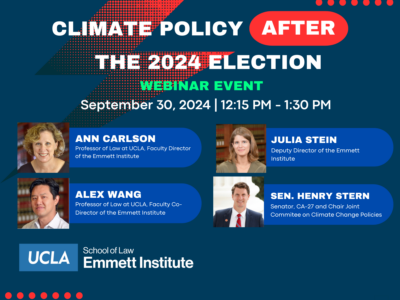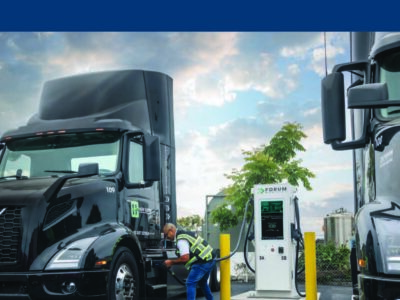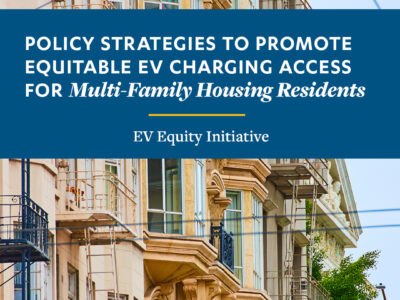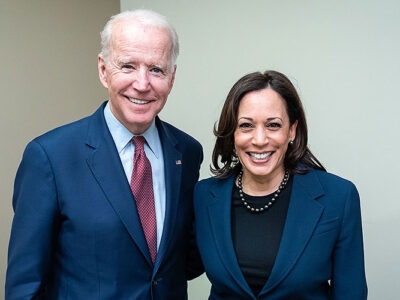Transportation
Climate Policy After the 2024 Election
In this UCLA Emmett Institute webinar, panelists discussed the climate implications of the 2024 election from the state, national, and international perspective.
Climate certainty. Legislative action. Whipsaw regulations. An exodus of civil servants. Chinese leadership despite being the world’s largest emitter. Those are a few of the possible outcomes of the Nov. 5 presidential election, according to our panelists. More than in any previous election, the two major candidates’ track records on environmental policies are well-established and …
Continue reading “Climate Policy After the 2024 Election”
CONTINUE READINGEvolving Energy Positions, 2016-2024
The national debate over climate and energy has shifted since Trump’s first run in 2016.
Coal, once a political flash point, has almost disappeared as an issue, with oil and gas production in unchallenged first place for Republicans. Clean energy subsidies, a side-issue in 2016,, have now taken center stage, while EPA regulations get much less attention. The one thing that remains unchanged is the gulf between the parties.
CONTINUE READINGCalifornia’s Electric Car Culture
The state has been pushing EVs for over thirty years, with huge progress in the past five years.
California has been a leader in clean cars — the result of a long history of regulatory efforts. Here’s how we got where we are, and what will need to happen going forward.
CONTINUE READINGChina, Climate, and Clean Energy
China seems to have leap-frogged the U.S. on clean energy. We need to catch up.
In 2023, China accounted for about 60% of the world’s additions of solar and wind power, and of electric vehicles. The U.S. will need to make a major effort to catch up. Otherwise, we risk being shut out of important global markets and giving China an opening to influence developing countries.
CONTINUE READINGElectric Shared Mobility:
Program Design Elements Can Produce More Equitable, Durable, and Successful Projects
Shared mobility—an umbrella term for any transportation mode shared among multiple passengers—has the potential to accelerate transportation electrification, air quality, and greenhouse gas reduction goals, meet the needs of underserved communities that most lack mobility access, and advance broader mobility equity goals. CLEE’s report, Electric Shared Mobility: California Lessons Learned for Equity in Program Design, …
Continue reading “Electric Shared Mobility:”
CONTINUE READINGCalifornia Pulls Back On Sustainable Aviation Fuels
Air Resources Board abruptly withdraws proposal to mandate low-carbon jet fuel
California regulators had an opportunity this year to be a global leader on requiring airplanes to use low-carbon jet fuel. But the Air Resources Board announced earlier this month that it will back off from its earlier proposal to require jet fuel providers to decarbonize, through the agency’s landmark low carbon fuel standard program. Why …
Continue reading “California Pulls Back On Sustainable Aviation Fuels”
CONTINUE READINGNew Report: Charging and Financing Electric Trucks
CLEE/UCLA Law report & webinar offers solutions to meet California’s zero-emission trucks goal
California has groundbreaking goals to require automakers to sell, and large fleets to purchase, zero-emission trucks and buses in increasing percentages, starting this year. But these goals will only be achievable if the state has sufficient charging infrastructure to fuel the vehicles, along with available financing to help truck owners purchase or lease them. To …
Continue reading “New Report: Charging and Financing Electric Trucks”
CONTINUE READINGEV Charging Access for Multifamily Housing Residents
New CLEE report highlights key findings for equity-oriented program design
The rapidly approaching electric vehicle (EV) transition that California and a dozen other states have committed to enact over the coming decade mounts pressure on state and local governments to deliver millions of new EV chargers across various location types. Homes constitute the core of a convenient and reliable charging network, and EV charging infrastructure …
Continue reading “EV Charging Access for Multifamily Housing Residents”
CONTINUE READINGBattery Technology and EVs Take Off: A Timeline
These interlinked technologies are crucial to the energy transition. Here’s their history.
To fight global warming, we need to largely eliminate the internal combustion engine as a form of transportation. We need battery technology for this and to store electricity, because wind and solar power are intermittent. These technologies didn’t appear out of thin air. Here’s the story of their rise
CONTINUE READINGDid Democrats Follow Through?
The 2020 Democratic Platform made some big promises. Four years later, where do things stand?
Many of the climate promises in the 2020 Democratic platform were kept, and large down-payments were made toward fulfilling others. The glass is definitely more than half full.
CONTINUE READING











